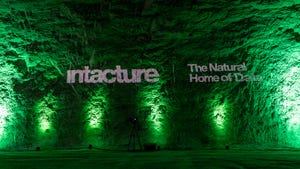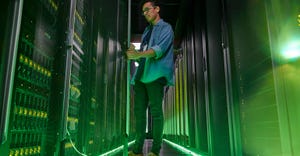IBM Cool Blue Shines in Vendor 'Chill Off' update from June 2008
IBM's Cool Blue Rear Door Heat eXchanger liquid cooling unit earned bragging rights in a vendor "chill off" that tested multiple vendor products in the same data center environment.
June 27, 2008
IBM's Cool Blue Rear Door Heat eXchanger liquid cooling unit earned bragging rights in a head-to-head vendor "chill off" that tested the energy efficiency of vendor cooling products in the same data center environment. The unusual competition between leading cooling technologies from IBM, APC, Emerson Network Power and Rittal Corp. was sponsored by the Silicon Valley Leadership Group (SVLG), which announced the results yesterday during the group's Data Center Energy Summit in Santa Clara, Calif.
Cool Blue, developed by IBM and licensed by Vette Corp., is a rear door heat exchanger that doesn't use fans, which gave it an energy advantage over competing products in the analysis, according to Dean Nelson, Senior Director of Datacenter Design Services at Sun Microsystems, who presented the findings. There was also keen interest in the results for APC and Emerson Network Power's Liebert unit, which wound up virtually deadlocked, with APC products faring slightly better at low power loads while Liebert's gear was more efficient as loads neared 10 kilowatts per rack, the upper limit for the testbed.
Rittal's LCP rack-based liquid cooling product trailed the pack. The full results and testing criteria for the chill-off are available on the Accenture web site (PDF) along with all of the 11 case studies presented during the SVLG energy summit.
The unusual contest was conducted in Sun Microsystems' data center in Santa Clara, with officials from Lawrence Berkeley National Labs overseeing the testing, and Modius providing the metrics with its OpenData Data Center Infrastructure Manager software. More than 40 million individual measurements were taken during the study.
The roots of the vendor chill-off date to 2003, when the idea was floated during a design charette organized by Rocky Mountain Institute. The idea was resurrected during an SVLG event last year, and got underway on May 24, 2007. The test racks featured up to 320 Sun V20z 1U servers, a reflection of a desire to test effectiveness on legacy gear, rather than the latest and most efficient servers. "We wanted to see what would happen with the ugly old servers," said Nelson. That approach had a tradeoff, limiting the test load to 10 kilowatts per rack.
The format provides customers with data to compare different products, as well as different approaches to cooling. APC's ACRC100 InRow cooling unit, for example, uses water cooling and attaches to the side of the server racks, while Liebert's XDV uses pump refrigerants and is placed atop the rack. But the results gave no clear verdict.
"Chilled water and refrigerant solutions with forced air performed equally, and overhead and in-row solutions performed equally," said Nelson.
The apples vs. oranges comparisons generated interest, but also left vendors plenty of room for spin and qualification. In a panel accompanying the results, Rittal said its gear would have fared better if more criteria had been considered. Liebert's Jack Pouchet noted that the chill-off didn't consider pricing of the products, which along with energy efficiency is a factor in the ROI. While participants found ways to advocate for their products and approaches, diplomacy carried the day, with no major trash talk between vendors.
Sun's Nelson called for more independent studies of competing equipment. "We should continuously be doing this," he said. "Let's do it again. Let's take Blackbox and Rackable and other containers and put them next to one another."
About the Author
You May Also Like
.jpg?width=300&auto=webp&quality=80&disable=upscale)



.jpg?width=300&auto=webp&quality=80&disable=upscale)


